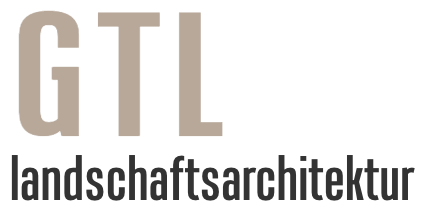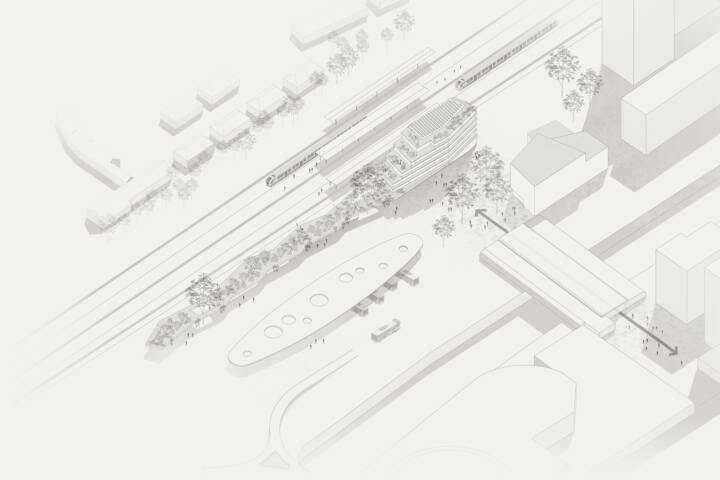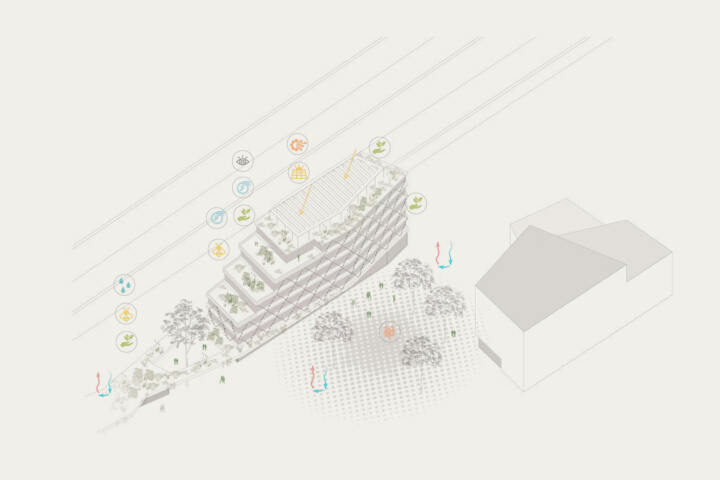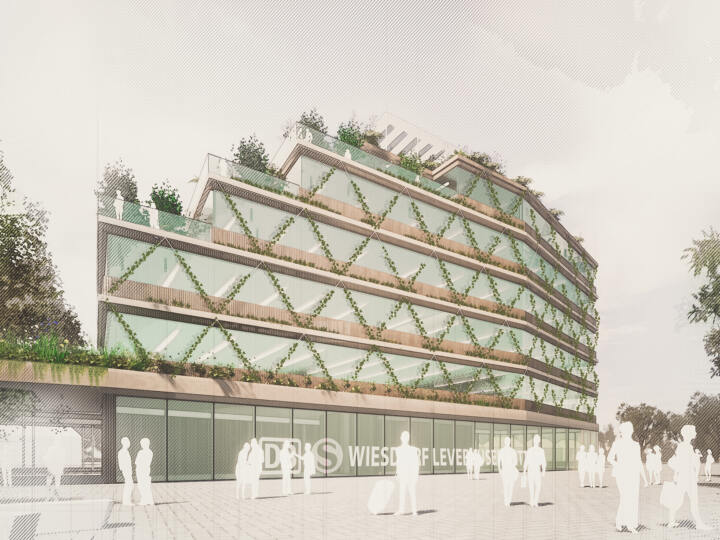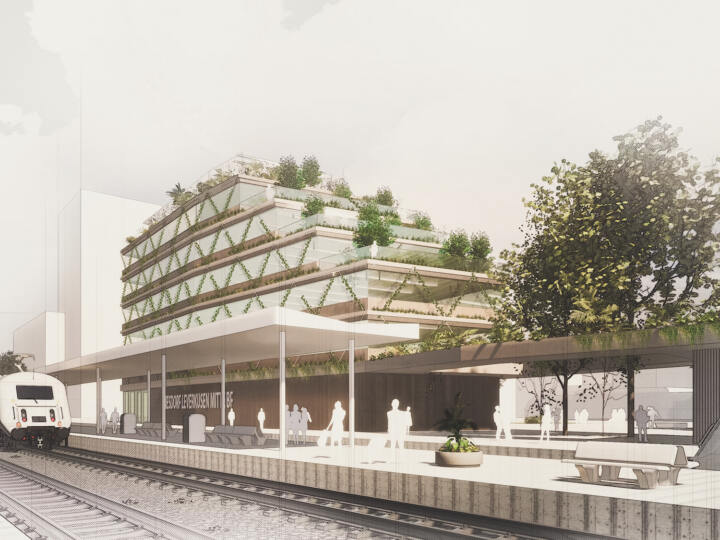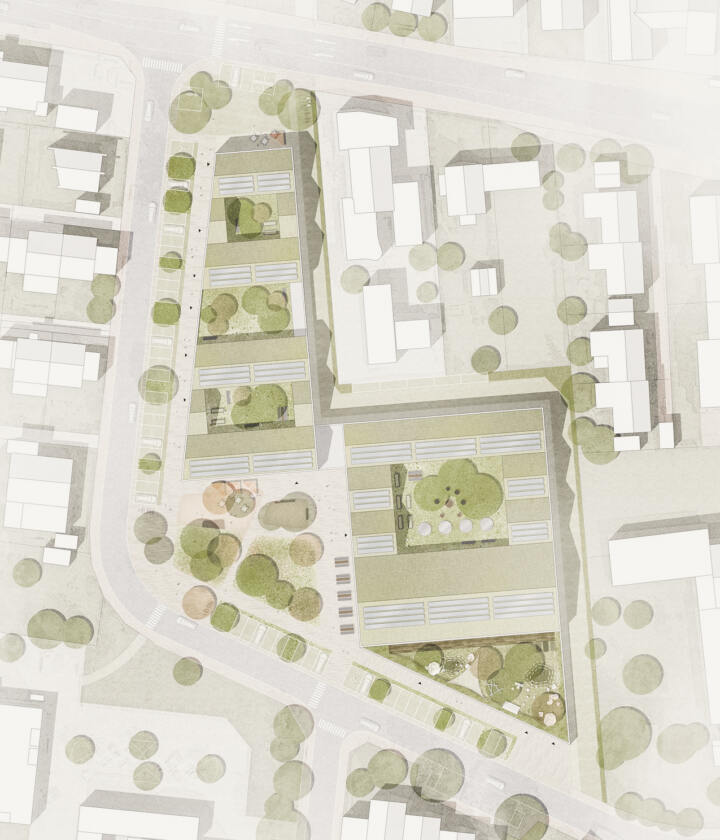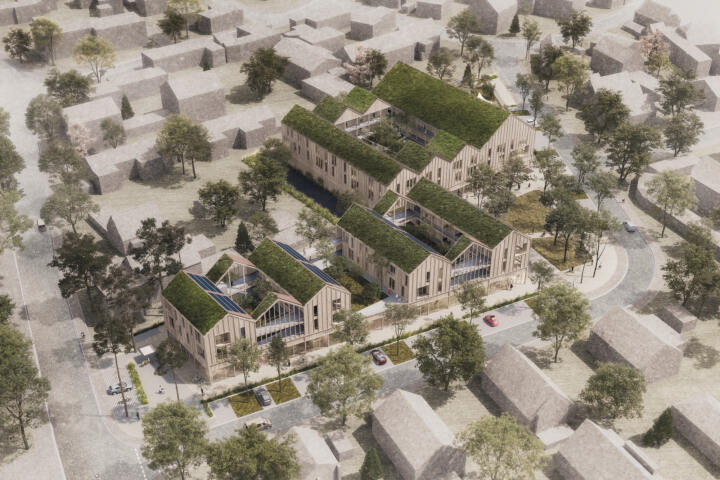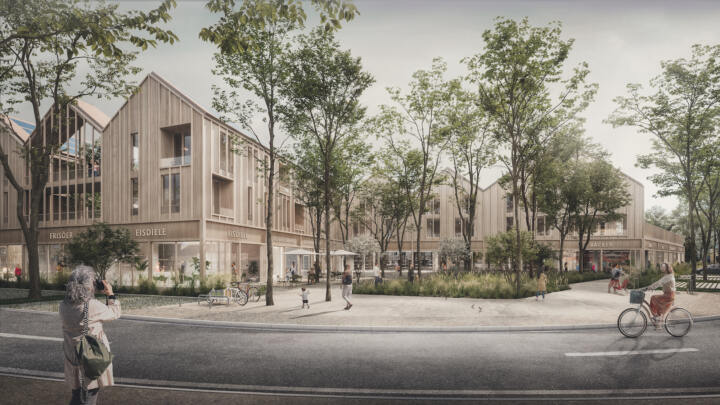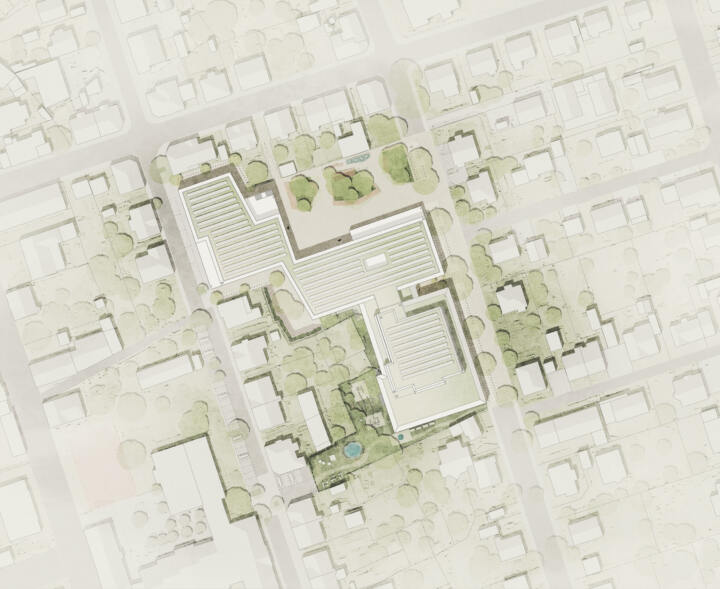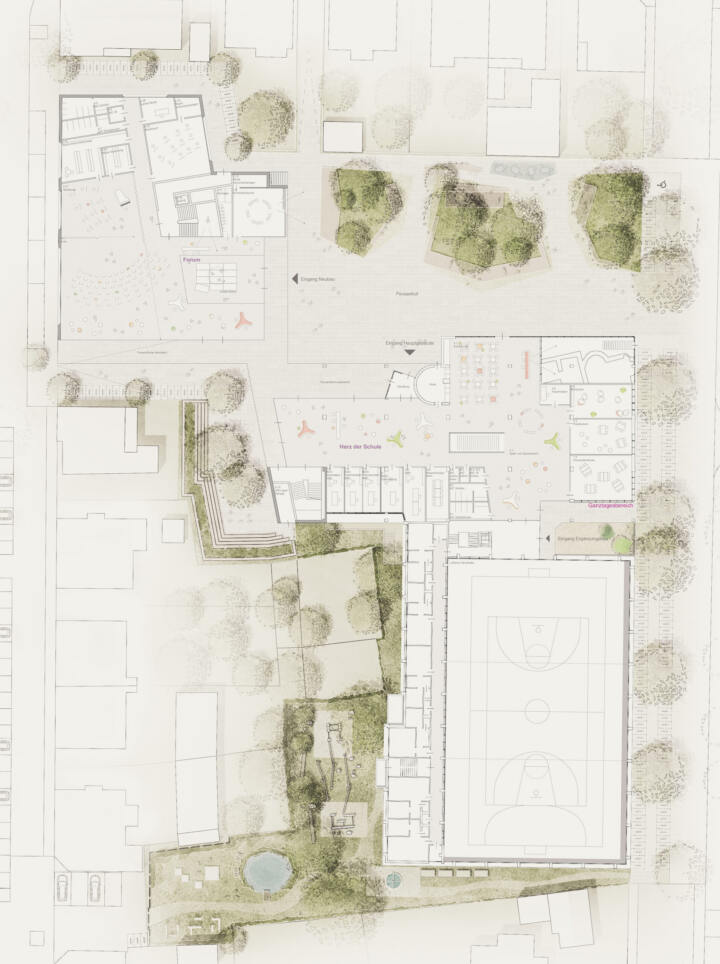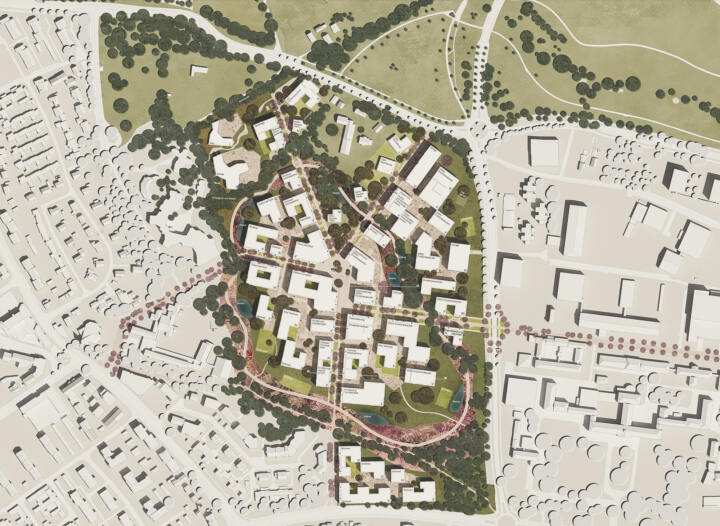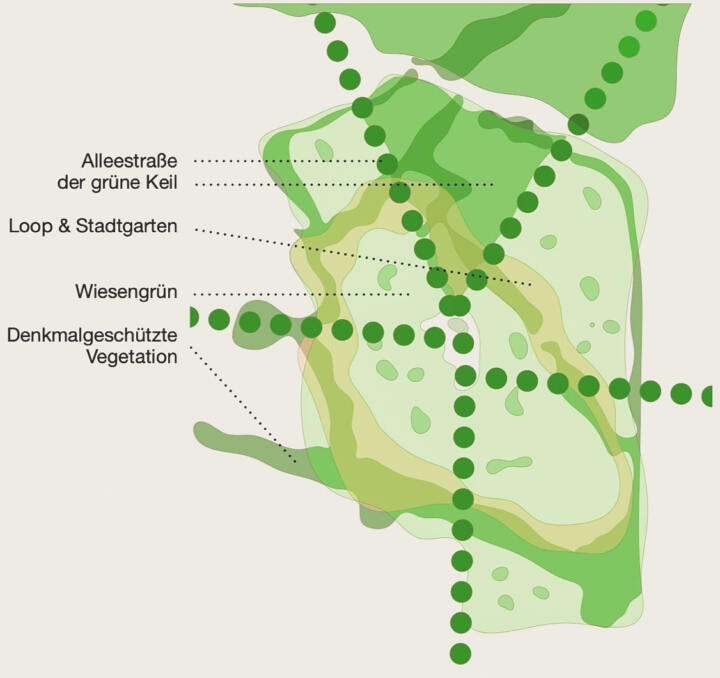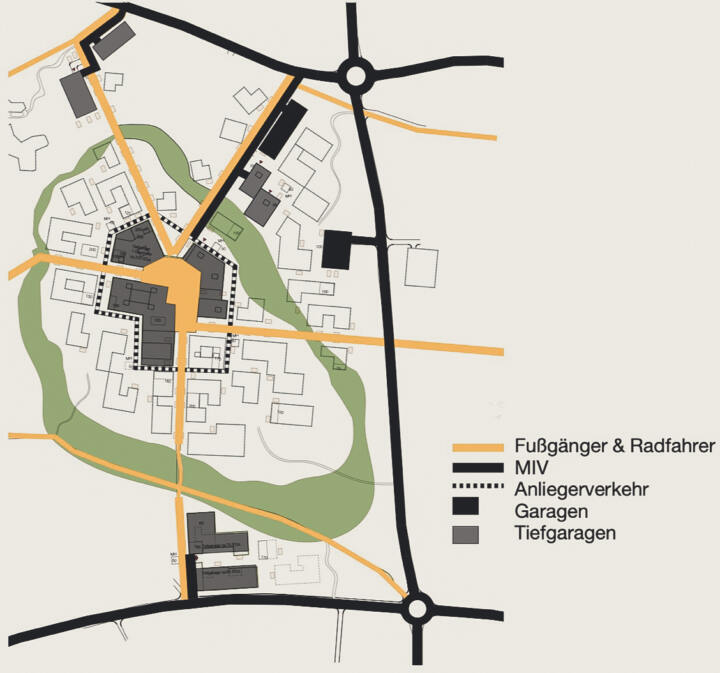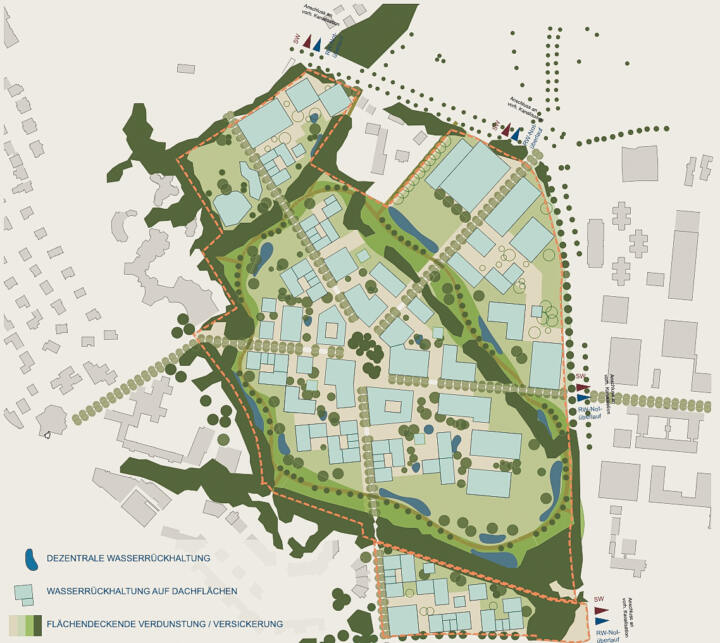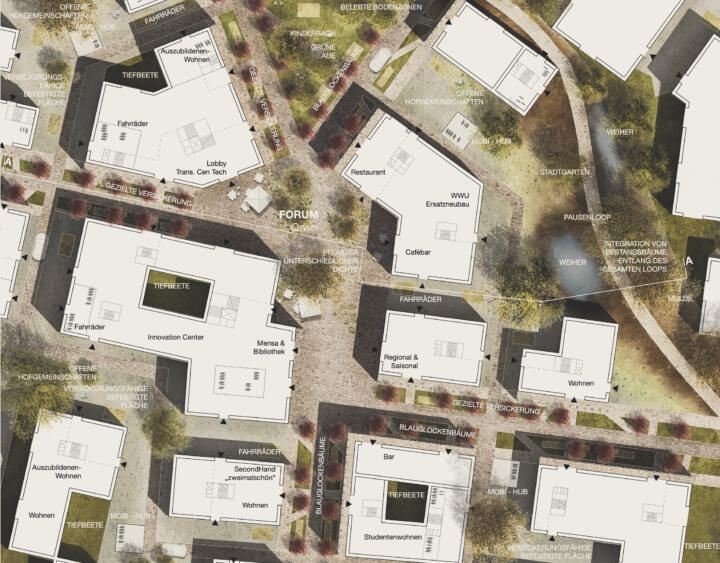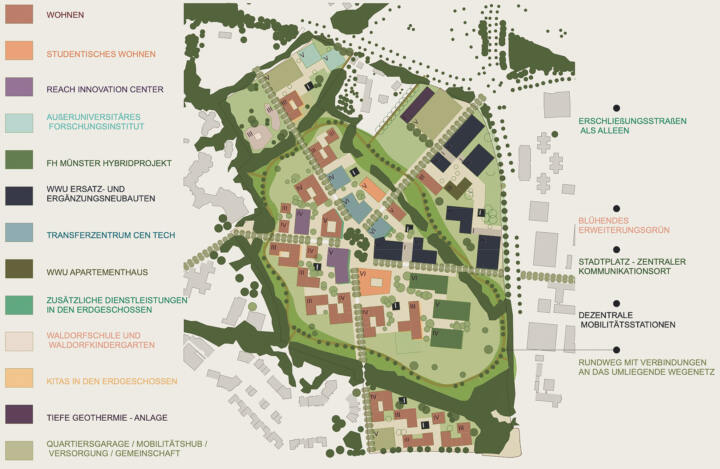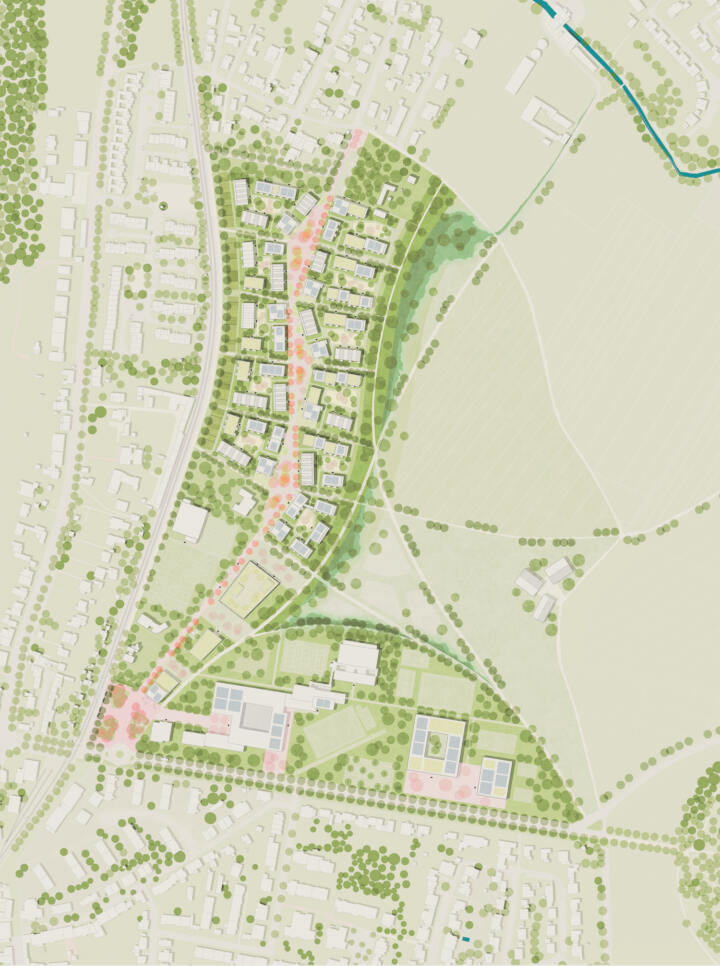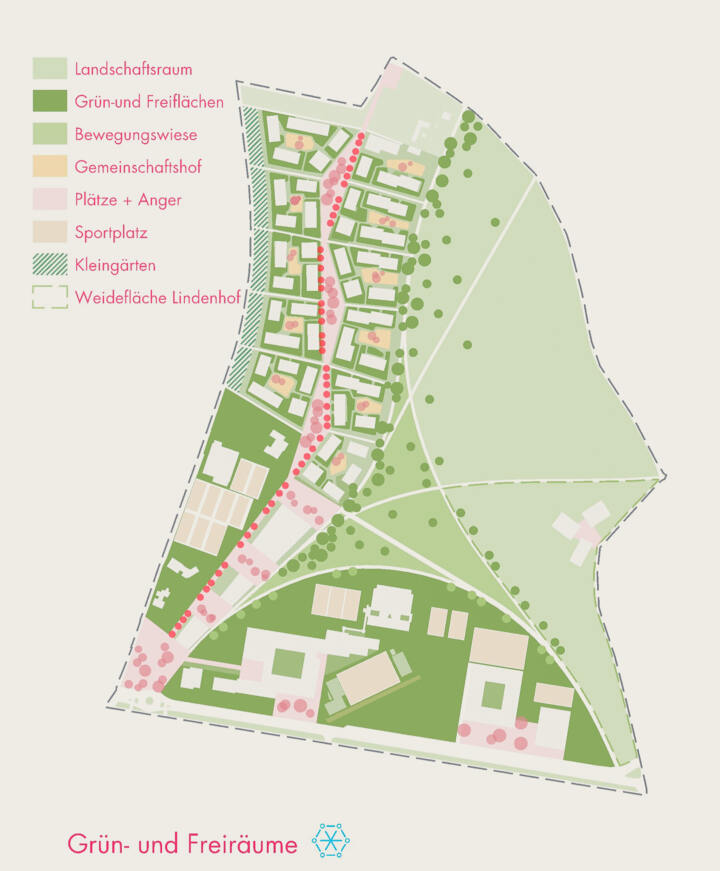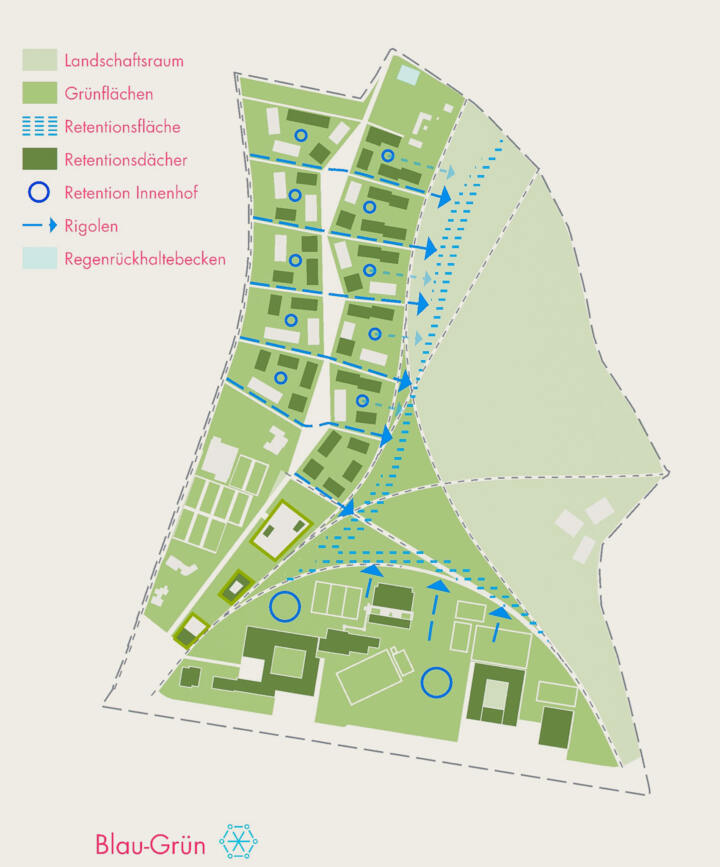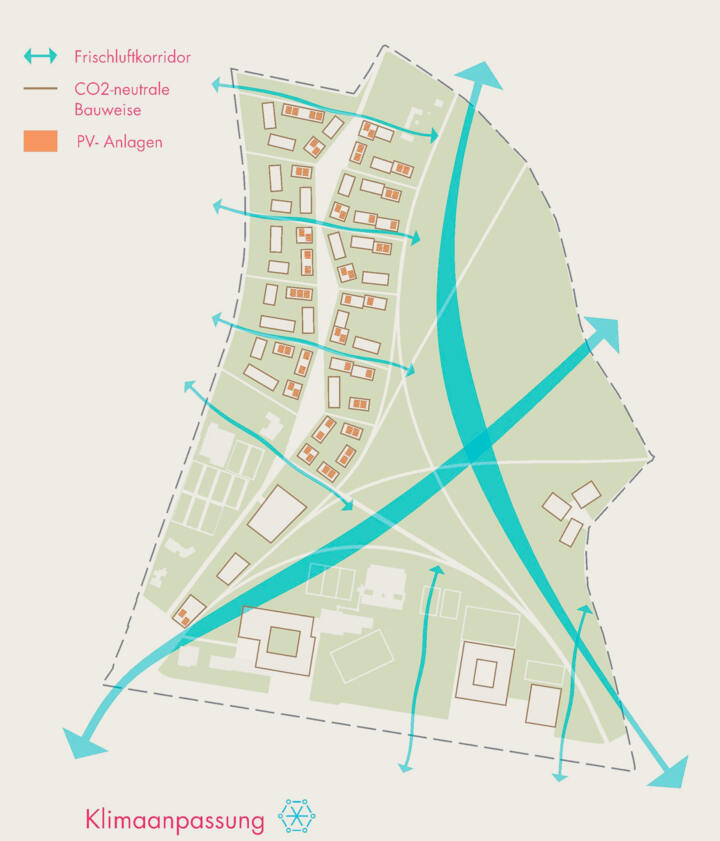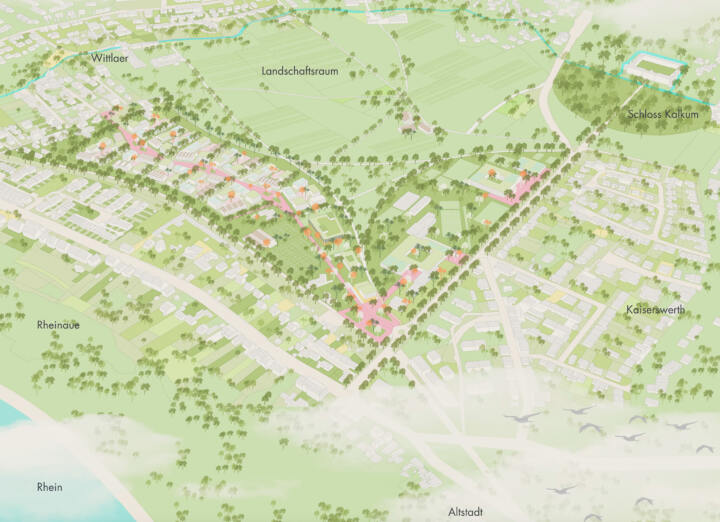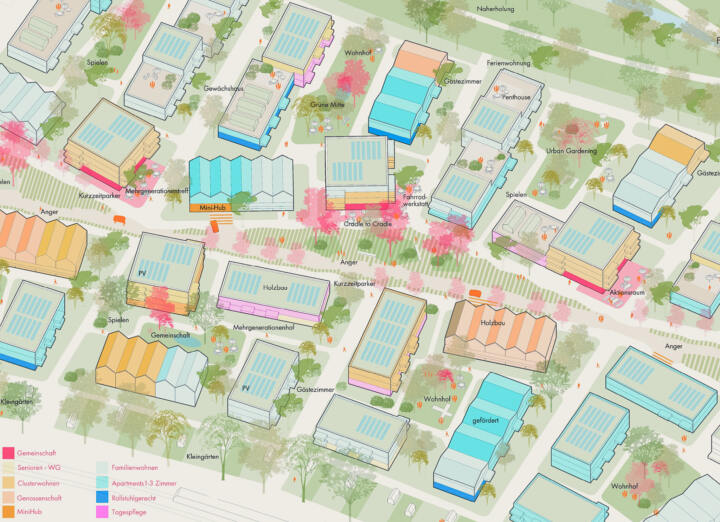Further development of Bahnhofsquartier | Leverkusen-Mitte
2nd prize | Further development of Bahnhofsquartier
Leverkusen-Mitte
In collaboration with Atelier30 Architekten
Key idea and urban development concept
The new station building with adjoining bicycle parking garage marks the new station entrance and access to the tracks with an appropriate high point and sets an example for the Wiesdorf/Leverkusen-Mitte station district. At the same time, the new development forms the transition and an appropriate prelude to the south to the newly developed post office site.
The cubature of the station building develops, stepped down like a terrace, out of the single-storey long building of the bicycle parking garage. The development is characterized by intensively greened roof and façade areas and represents a visible contribution to urban development. The bicycle parking garage is subdivided into several parking areas. The angled arrangement of the bicycle boxes defines the space towards the central bus station and yet does not place the bicycle highway in the second row. With the new possible crossings, the cycle highway is connected to the central bus station/station square and not relegated to the second row behind the bicycle parking garage as a mere “through lane”. The cantilevered roofing in the area of the first floor offers protection for additional bicycle parking spaces and the possibility of storage. The building can be constructed in two separate parts.
Open space concept
Opposite the large traffic area of the bus station, the new station forecourt acts as a green link between the unvegetated functional area – the new station and office building and Rialtoboulevard. The interplay between paved surfaces, tree-covered areas of grasses and shrubs and a water feature means that the square not only fulfills its function as a high-traffic transit space, but – equipped with robust street furniture – also becomes an attractive place for waiting people, strollers and visitors to the restaurant. As the adjacent traffic areas are expected to become even hotter in the future, the station forecourt outside the movement areas will be covered with large-crowned, shady trees, which, in combination with the evaporative cooling effect of the fountain, promise a significant cooling effect. The roadway for the buses in the square area will be made of in-situ concrete with the same aggregates and the same color nuances as the pavement in order to ensure a consistent, uniform overall impression.
Local Supply | Göttingen
2. Prize | Local Supply
Göttingen
In collaboration with pape+pape architekten
The open space concept of the new local shopping centre is defined by generous open and green spaces, which lead to a transformation of the place in which the car is no longer in the foreground.
The spatially sophisticated building design integrates further green spaces into the building itself. The inner courtyards on the first floor take numerous other opportunities out of the buildings to make the centre even greener.
The forecourt opens up the local shopping centre to the neighbourhood and develops into a public square for everyone. The significant reduction in paved areas allows water to seep away more easily and fits in with the sponge city concept.
The preservation of the existing trees and the planting of additional deciduous trees and fruit trees are particularly important for this, but the use of grass paving for the car parks also contributes to this. The remaining paved areas will be fitted with light-coloured concrete block paving.
Numerous seating and recreational areas will also be integrated, which can be found at the café in the north or at the neighbourhood square.
The roof garden and inner courtyards also create a special place to relax and meet with seating and vegetation.
In addition to car parking spaces, particular emphasis is placed on a large number of bicycle parking spaces. Bicycles can be parked at various locations; cargo bikes and e-bikes of all kinds can also be charged and parked, making the local shopping centre modern and inviting. This is supported by parking spaces for car sharing, micro and light vehicles and areas for mixed use.
The daycare centre’s raised garden, which is located on the first floor and protected by wide shrubbery, is particularly noteworthy. In addition to play hills and play elements, there are also other deciduous and fruit trees here, which, in combination with beds in the raised garden and inner courtyard, invite children to plant and eat their own food.
Eugen-Bolz-Secondary School | Rottenburg
Recognition | Eugen-Bolz-Secondary School
Rottenburg
In collaboration with Atelier 30
The existing school area is implemented in a structurally heterogeneous environment.
The new heart of the school landscape is located in the forum of the new building. The central space, which includes a gallery, offers many possibilities for use by the school community.
The future traffic development consists of a successful mix of motorised private and public transport, as well as cycling and pedestrian traffic. With the exception of a few barrier-free parking spaces, cars are parked outside the school area and the existing school grounds are implemented in a structurally heterogeneous environment.
The urban positioning of the buildings on Eberhardstrasse is orientated towards the important footpath connection in the direction of the public transport stops, and opens up the schoolyard in a meaningful way, which, as in the existing building, connects to the footpath in the direction of Sophienstrasse in the north (barrier-free access via a ramp) and opens up towards Mechthildstrasse.
The sections of the open spaces correspond closely to the new school building. The forecourt, which opens onto the street, leads directly into the “heart” of the school campus, the central courtyard between the old and new buildings. The fact that a large part of the courtyard is underpinned by a bunker requires raised planting beds for the necessary tree planting. Chill and learning decks alternating with seating steps turn the resulting raised beds into meeting places during breaks and free periods. The cubature of the raised beds is orientated towards the building structures and creates flowing, semi-open spaces that allow individual occupation of the courtyard while maintaining the necessary clarity. A partially covered area for learning and working at group tables and benches is provided in the northern part of the courtyard, somewhat separated from the break area.
The large playground offers sufficient space for exercise, especially for the younger age groups. The existing exercise facilities to the west of the gymnasium will be supplemented by additional facilities such as calisthenics equipment and parcours elements.
In addition to the requirements of the exercise and learning landscape, the open spaces also fulfil fundamental functions of resilient and sustainable area development. These include a maximum of structurally rich vegetation areas, water-permeable surface paving and rainwater management as a circulation system. All roof surfaces of the school buildings are intensively greened – an approx. 20-30 cm thick layer of substrate stores the rainwater and makes it available to the plants. Where possible, rainwater from the paved areas is channelled into the drainage and storage layer of the raised tree beds and also collected in cisterns for the use of service water.
Busso-Peus Street | Münster
Recognition | Busso-Peus Street
Münster
Concept ❘ A centre, a network full of character, a ring path and the existing, extended vegetation form the basis of the concept for Münster Model Quarter 2. This “nature hybrid” is intended to be an international demonstration project for how sustainable housing and university construction can be combined with intensive reforestation, increased biodiversity and circular resource thinking in a suburban and peri-urban area. Dense and socially networked neighbourhoods are created. What is important is an urban structure in the centre that provokes education, exchange and community and expands along the “avenues”.
The urban-natural landscape ❘ The city and the university merge into a dense sub-centre. The existing vegetation becomes the starting point for a park – for an urban-natural landscape. The urban development project is intended to become a laboratory for the development of a close symbiosis of living and working environments in areas close to the city and help the city of Münster to realise its ambitious nature and climate protection goals. The overlapping of uses will enable a new urbanity on the outskirts of the city. A centre and structural density, consistent networking with the surroundings, the strong framework of tree structures and a mule track through the intensive natural garden are the basis of our concept for Model Quarter 2 in Münster.
Open space concept ❘ A central square forms the heart of the new neighbourhood – a forum. This is where the opportunities for exchange, learning and research are concentrated. Open courtyard communities that form around the central square merge into the landscape. Their informal design allows for diverse appropriation and is characterised by the “open” green surfaces.
The neighbourhood is also surrounded by an open landscape area with meadows for play and sport and additional space for animal enclosures and the learning garden.
A flowering perennial field with a walking path and jogging track surrounds the Allende. This serves as a break and after-work diversion and connects the individual courtyard communities.
Existing rows of trees of the natural monuments remain untouched, are supplemented and form a spatial setting. The Appelbreistiege will be crossed carefully and with narrow bridges over the existing ditches. This crossing is kept to a minimum and is designated exclusively for pedestrians and cyclists.
The green corridor along the Kinderbach stream in the north of the site will be brought right up to the central square of the new neighbourhood. This will provide the existing courtyard complex and even smaller individual buildings in the neighbourhood with a lush green environment.
Path and traffic concept ❘ Star-shaped avenues open up the site. They connect to the existing network of paths and meet in the centre of the site. They connect the new district with neighbouring areas such as the research campus, Münster’s city centre and the centre of Gievenbeck. The most important connection is the route from the city centre via the research campus to the centre of the new quarter. The junction with Busso-Peus-Straße is emphasised by a circle of trees and the new buildings on the west side form a gateway to the new quarter. Of the total of five access roads, four are intended exclusively for pedestrians and cyclists. Each street is lined with green spaces and framed by the buildings.
Coming from the north, from Gievenbecker Weg, motorised traffic will be routed to the central square under the underground car park. Delivery, emergency and refuse vehicles can drive through the neighbourhood on a ring road. The courtyard communities can be delivered via the gravelled lawn areas.
Drainage concept ❘ The design follows the principle of the “sponge city” with the components of evaporation, storage and infiltration of rainwater. If the surface materials allow a low level of evaporation or infiltration, the rainwater that accumulates on the open spaces is channelled to troughs and deep beds via suitably designed open ditches or via cross-slopes created on the paths and squares. These are designed for a high evaporation capacity through appropriate planting, in some cases with trees, and are designed in such a way that they also improve the quality of stay and the microclimate.
In addition, retention areas are used for the temporary storage of rainwater for delayed reuse. Part of this is utilised for water storage and groundwater recharge via infiltration trench systems, tree-riogole systems and additional underground systems.
Kalkumer Schlossallee | Düsseldorf
3. Prize | Kalkumer Schlossallee
Düsseldorf
Landscape shapes the city
In collaboration with schneider+schumacher
The “Landschaft formt Stadt” concept envisages a nature-based and sustainable neighbourhood that takes into account the outstanding quality of the settlement area to be developed with its exposed location to the open landscape, its proximity to the Rhine and the historic old town of Kaiserswerth.
Urban and open space planning concept
The identity is characterised by the direct integration of the landscape and the mix of housing types. The green and open space extends from the Kalkumer Schloßallee railway station to the landscape (in the direction of Bach-Aue) and divides the urban figure into a multi-generational campus in the west and an educational campus in the south of the planning area. This creates a clearly defined edge to the town, formulating a visual reference to the open landscape. The shaping of the landscape space between the residential areas creates strong ventilation and greenery. Residents will be able to experience the space as a local recreation area. The overarching network of footpaths and cycle paths connects the open landscape with the surrounding neighbourhoods. The urban planning organisation defines interconnected building plots in the sense of an “urban village”, which provides for a diverse and flexible building structure for different forms of housing and architecture, and for several generations.
Transport/mobility concept
The area is characterised by excellent public transport connections. This is ensured by the railway station “Kalkumer Schlossallee” in the south-west and “Am Mühlenacker” in the north-west as well as a bus stop on Kalkumer Schlossallee. The concept envisages that only an efficient road connection between the neighbourhood in the south and Kalkumer Schlossallee is to be realised.
Open spaces
All squares and streets follow the principle of the sponge city with the highest possible proportion of unsealed surfaces. Where sealed areas are required, care is taken to use permeable surfaces wherever possible. In addition, the green areas are slightly recessed in order to retain rainwater and allow it to seep away and evaporate directly on site. This mix of green and paved areas also offers a wide variety of recreational and play areas. The entrance to the new neighbourhood is formed by a large square that connects the railway station, the school and the new residential area. Various meeting and recreational areas for young and old will be created here, structured by large green spaces. In the residential neighbourhood, the village green will create attractive public squares and play areas without traffic congestion. Semi-public residential courtyards and the private and communal green spaces assigned to the ground-floor flats will be created, resulting in communicative neighbourhoods. The northern end will have a small square with a play area as an entrance from the existing residential development. In addition to the obligatory climate resilience of the large trees, the choice of plants is orientated towards a flower-rich, near-natural appearance with high drought tolerance, which not only strengthens biodiversity but also offers varied flowering aspects throughout the year.Small climatic forests will be planted on the edges of the railway and school campus to act as a buffer to the buildings.All footpaths in the landscape area are loosely accompanied by fruit trees and link up with the surrounding network of paths – the landscape area thus retains its expanse.It is proposed to relocate the existing Lindenhof riding centre to the landscape area, as this will allow for future expansion and development.The sports and leisure areas, including the three extended tennis courts, are arranged in such a way as to create synergies with the utilisation of the open spaces.

